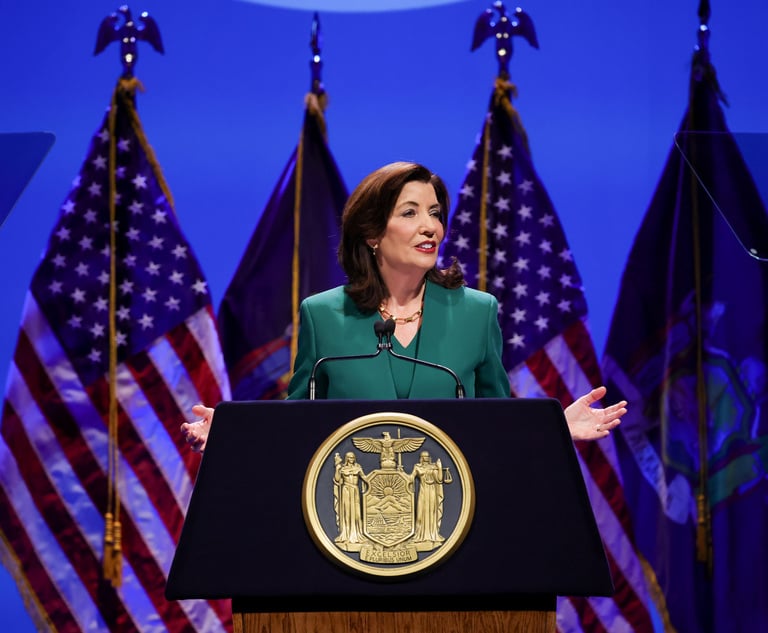 Photo: Le Panda/Shutterstock
Photo: Le Panda/Shutterstock Remote Notarization Is Here, Now: A Giant Step Forward for New York's Notary Laws
New York finally has a technologically advanced notary law with robust anti-fraud protections for remote notarization equal to or better than those of every other state.
March 30, 2022 at 11:15 AM
16 minute read
During the pandemic, New York's notary laws were exposed for what they were—an archaic hold-over that permitted only in-person notarization of paper documents with ink signatures. New York, the world's commercial capital, had ignored 20 years of technological advances and fallen behind the other 38 states that authorized secure notarization of electronic documents (e-notarization) and allowed notaries to remotely "meet" and accurately identify signers online. New York notarial law, which was also virtually unregulated, had stagnated while an epidemic of paper deed fraud raged.
The necessity of remote notarization became clear during the lockdown. The Governor's Executive Order 202.7 allowed the use of Zoom to enable remote notarization of client ink-signatures on paper documents (commonly called RIN, short for Remote Ink Notarization). Without the ability to have electronic documents notarized by New York notaries, lawyers used out-of-state notarial companies to notarize electronic documents using online identification procedures (commonly called RON, short for Remote Online Notarization). Authenticated copies were then "papered-out" and could be recorded in New York or easily apostilled for recordation in other countries. RON turned out to be not only startlingly convenient, but also, when done properly, substantially more protective against fraud than traditional in-person notarization of paper documents. Tamper-evident electronic document technology protected against post-signing alteration, and online identification procedures and the audio-visual recording of the signing prevented forgery.
This content has been archived. It is available through our partners, LexisNexis® and Bloomberg Law.
To view this content, please continue to their sites.
Not a Lexis Subscriber?
Subscribe Now
Not a Bloomberg Law Subscriber?
Subscribe Now
NOT FOR REPRINT
© 2025 ALM Global, LLC, All Rights Reserved. Request academic re-use from www.copyright.com. All other uses, submit a request to [email protected]. For more information visit Asset & Logo Licensing.
You Might Like
View All
Silk Road Founder Ross Ulbricht Has New York Sentence Pardoned by Trump
3 minute read
Bipartisan Lawmakers to Hochul Urge Greater Student Loan Forgiveness for Public-Interest Lawyers


Anti-Abortion Groups' Challenge to New York's 'Boss Bill' Is Returning to Federal Trial Court
Law Firms Mentioned
Trending Stories
Who Got The Work
J. Brugh Lower of Gibbons has entered an appearance for industrial equipment supplier Devco Corporation in a pending trademark infringement lawsuit. The suit, accusing the defendant of selling knock-off Graco products, was filed Dec. 18 in New Jersey District Court by Rivkin Radler on behalf of Graco Inc. and Graco Minnesota. The case, assigned to U.S. District Judge Zahid N. Quraishi, is 3:24-cv-11294, Graco Inc. et al v. Devco Corporation.
Who Got The Work
Rebecca Maller-Stein and Kent A. Yalowitz of Arnold & Porter Kaye Scholer have entered their appearances for Hanaco Venture Capital and its executives, Lior Prosor and David Frankel, in a pending securities lawsuit. The action, filed on Dec. 24 in New York Southern District Court by Zell, Aron & Co. on behalf of Goldeneye Advisors, accuses the defendants of negligently and fraudulently managing the plaintiff's $1 million investment. The case, assigned to U.S. District Judge Vernon S. Broderick, is 1:24-cv-09918, Goldeneye Advisors, LLC v. Hanaco Venture Capital, Ltd. et al.
Who Got The Work
Attorneys from A&O Shearman has stepped in as defense counsel for Toronto-Dominion Bank and other defendants in a pending securities class action. The suit, filed Dec. 11 in New York Southern District Court by Bleichmar Fonti & Auld, accuses the defendants of concealing the bank's 'pervasive' deficiencies in regards to its compliance with the Bank Secrecy Act and the quality of its anti-money laundering controls. The case, assigned to U.S. District Judge Arun Subramanian, is 1:24-cv-09445, Gonzalez v. The Toronto-Dominion Bank et al.
Who Got The Work
Crown Castle International, a Pennsylvania company providing shared communications infrastructure, has turned to Luke D. Wolf of Gordon Rees Scully Mansukhani to fend off a pending breach-of-contract lawsuit. The court action, filed Nov. 25 in Michigan Eastern District Court by Hooper Hathaway PC on behalf of The Town Residences LLC, accuses Crown Castle of failing to transfer approximately $30,000 in utility payments from T-Mobile in breach of a roof-top lease and assignment agreement. The case, assigned to U.S. District Judge Susan K. Declercq, is 2:24-cv-13131, The Town Residences LLC v. T-Mobile US, Inc. et al.
Who Got The Work
Wilfred P. Coronato and Daniel M. Schwartz of McCarter & English have stepped in as defense counsel to Electrolux Home Products Inc. in a pending product liability lawsuit. The court action, filed Nov. 26 in New York Eastern District Court by Poulos Lopiccolo PC and Nagel Rice LLP on behalf of David Stern, alleges that the defendant's refrigerators’ drawers and shelving repeatedly break and fall apart within months after purchase. The case, assigned to U.S. District Judge Joan M. Azrack, is 2:24-cv-08204, Stern v. Electrolux Home Products, Inc.
Featured Firms
Law Offices of Gary Martin Hays & Associates, P.C.
(470) 294-1674
Law Offices of Mark E. Salomone
(857) 444-6468
Smith & Hassler
(713) 739-1250






